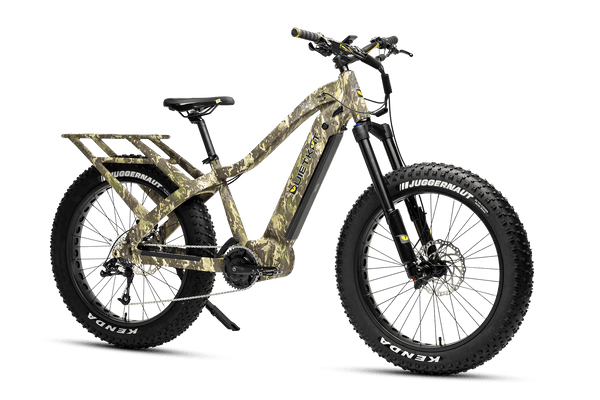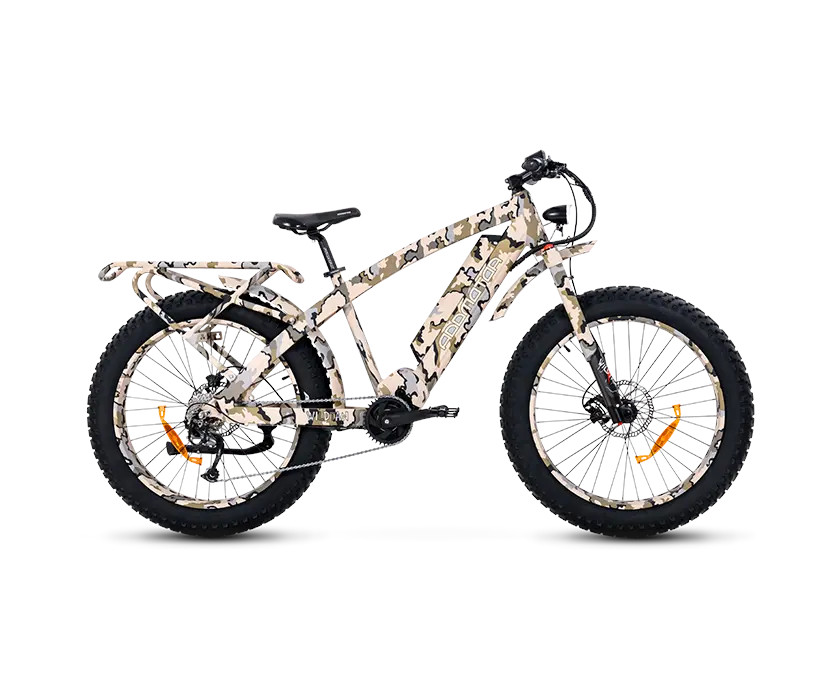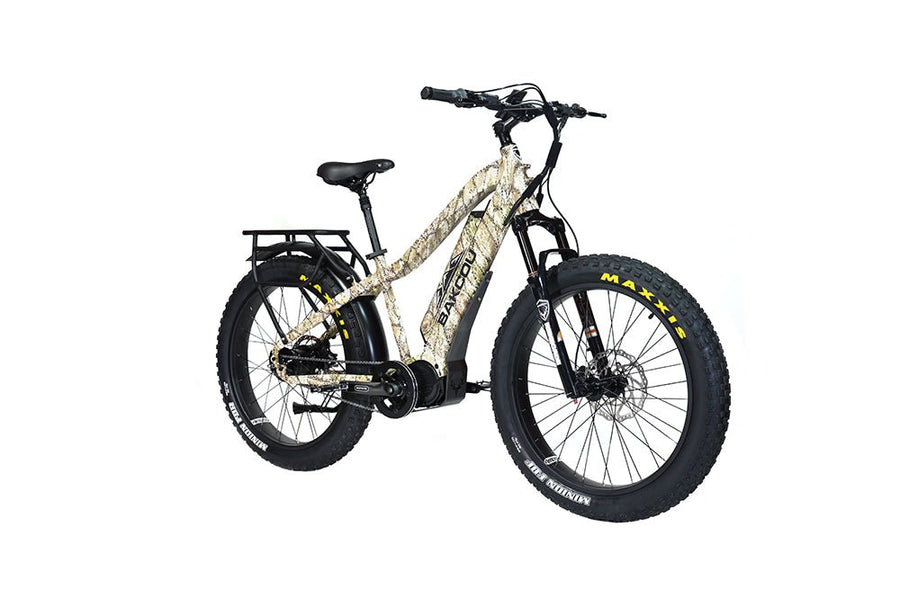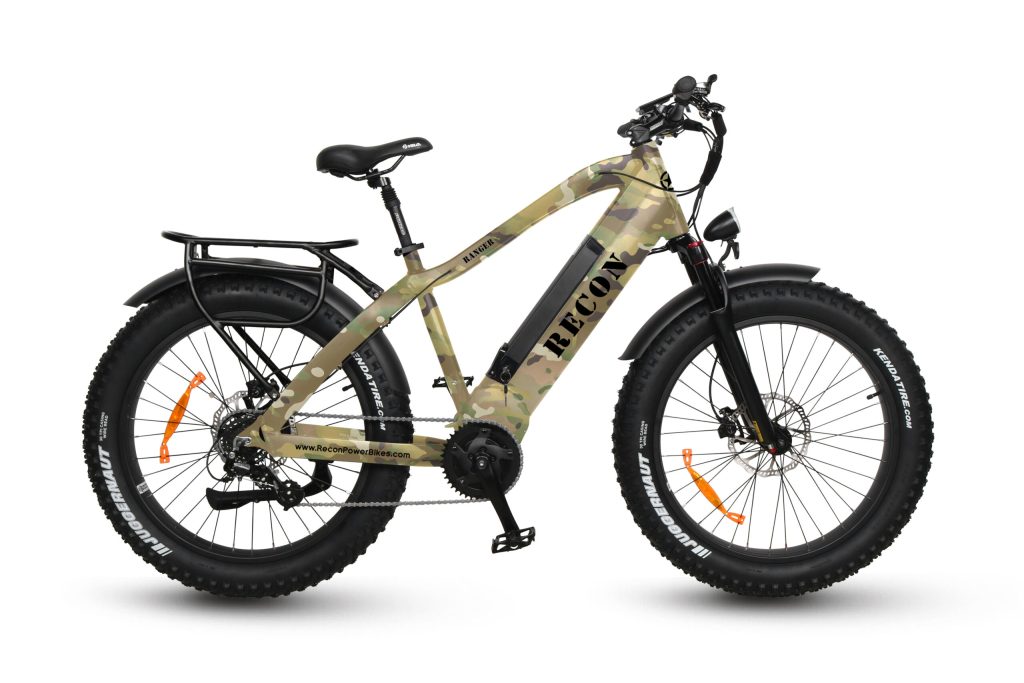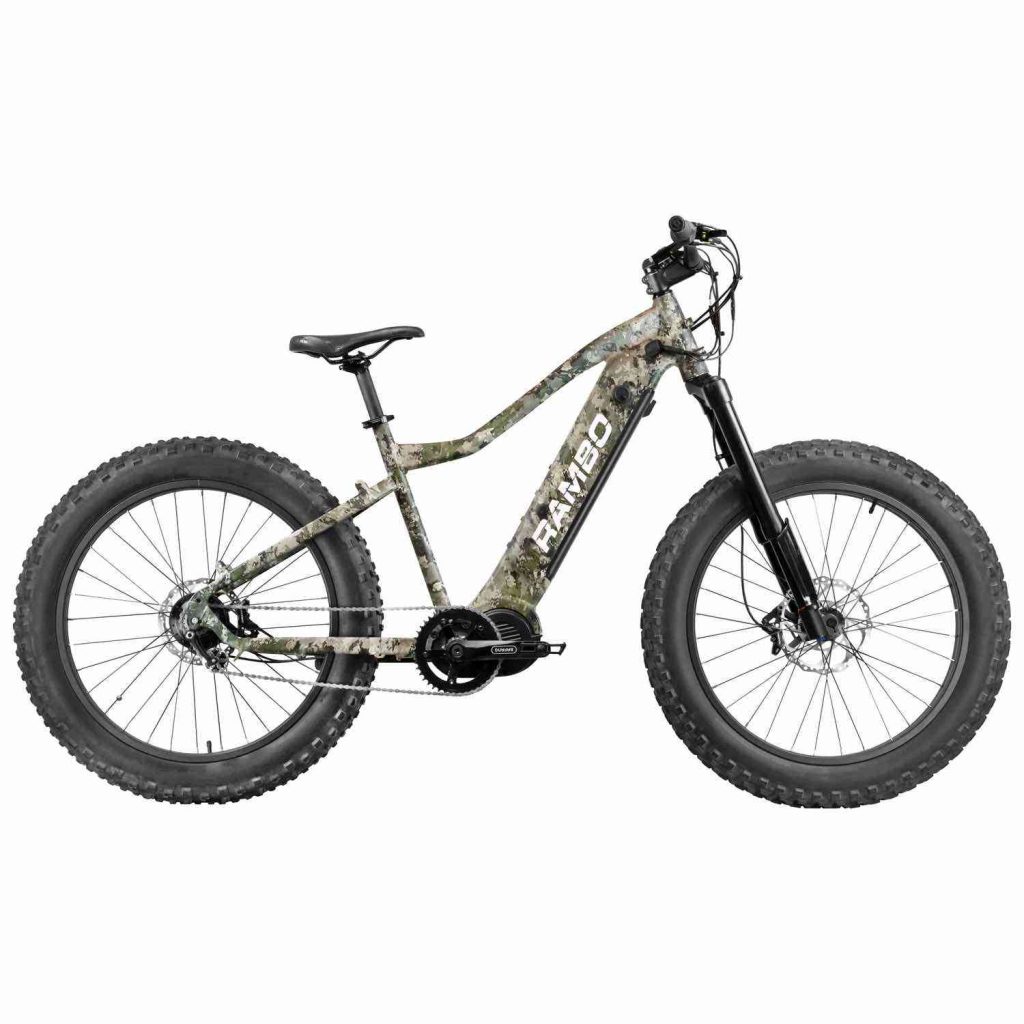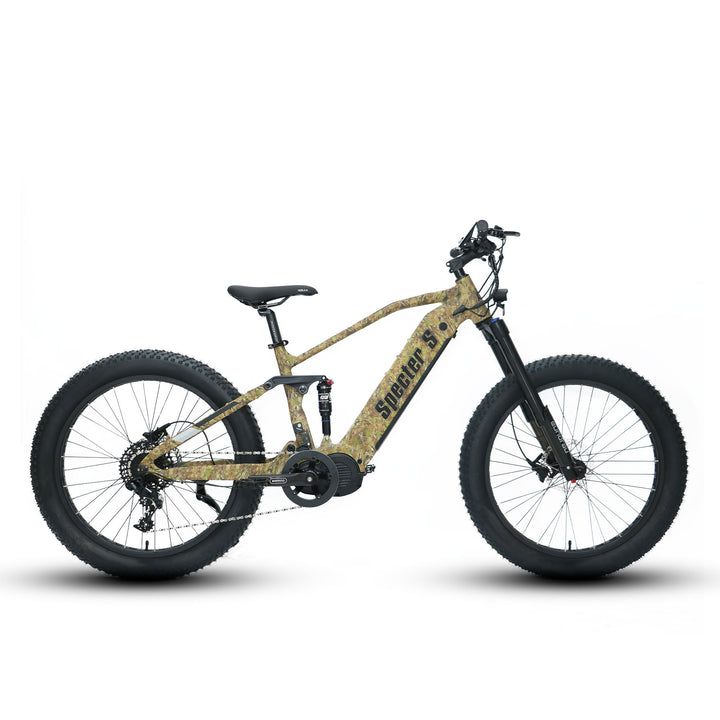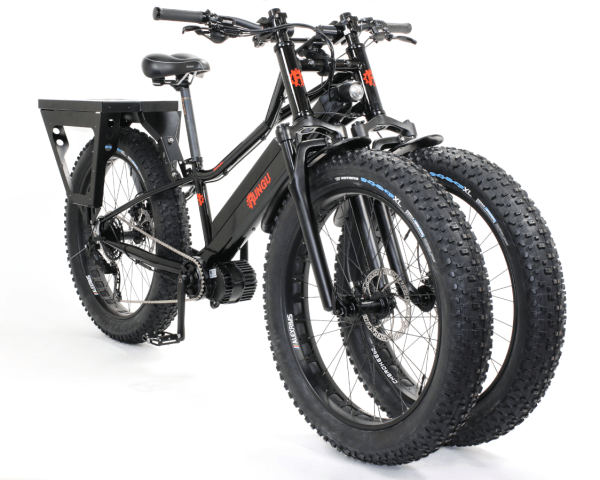Hunting has been a popular pastime for centuries, but as technology advances, so do the tools and equipment used by hunters. One such innovation is the electric hunting bike, and thousands of hunters are purchasing these as the latest addition to their gear arsenal. Electric hunting bikes offer a variety of benefits over traditional hunting methods, including increased mobility, reduced physical strain, and reduced hunting pressure. Here is your primer on choosing the best electric bike for hunting.
What Makes an Electric Hunting Bike?
While general ebikes and electric hunting bikes have similarities, there are differences, too. While both classes are quiet, the goal of the best hunting ebike is to operate even quieter. That’s necessary for those who are riding near wild game.
Oftentimes, hunting ebikes require sturdier frames that can carry more weight, too. Most electric bike enthusiasts don’t carry as much gear as hunters, so, hunting ebikes need larger, more durable frames.
These also tend to have heavier, wider tires. This is necessary to increase stability over difficult, uneven terrain. It also helps support heavier payloads, which is common with hunting.
Electric mountain bikes for hunting generally need to handle rougher terrain, too, especially when traversing rugged, hard-to-reach areas. This requires a better suspension, which most hunting-focused ebikes incorporate into their builds.
These models also tend to include better accessories that hunters need. Or, at least, they are compatible with accessory add-ons. Some also can haul trailers, which is great for towing extensive amounts of gear, or even wild game out of the woods.
What to Look for in the Best Electric Hunting Bikes
Hunters who are seriously in the market for an electric hunting bike should remember certain things. Like any vehicle, it’s good to look at the specifications, so that hunters get what they need out of their purchase.
First, look at the power it has. This is largely dictated by the motor, its type, the gearing, and the power supply it uses. A 250-watt bike is really a flat-land e-bike with minimal weight capacity.
Generally, 500 watts is the minimum most hunters should consider, and yet, it too likely won’t have the ability to tackle rugged terrain for extended periods. Those who want the most out of their electric hunting bikes should stick to 750 and 1,000-watt bikes, terrain-depending.
Range is another important factor, especially for those who are covering greater distances. While some might be able to work with the 20- and 30-mile ranges some bikes offer, it might be best to stick to models that have 40-plus-mile ranges. Some even extend into the 60s, 70s, and beyond. Of course, battery type, weight, and other factors impact this.
Weight ratings are also a consideration, especially for larger hunters, and those who wish to carry/tow more gear. This is also true for those who wish to pull trailers and haul downed game out of the timber.
While I wouldn’t generally consider aesthetics as an important factor for an ebike, in this case, it is. You want a model that is low-key, isn’t flashy, and doesn’t reflect a lot of light. As a hunter, you want something that stays off the radar, not something that grabs attention.
Warranty is another thing to look at. Hunters are hard on their equipment. Wear and tear happens, but it’s best to choose the product that exceeds the average lifespan of its product class. Observing the length of the warranty can clue hunters in on how long it should last.
Of course, price is a factor for most hunters. We all want to stay under budget, and keeping an eye on that price tag is a requirement for doing that. Know what you want, and what you can spend, and stay within those parameters.
Overall, it’s important to compare features between electric hunting bike market options, the benefits of each manufacturer’s products and designs, as well as your own personal needs as a hunter. Do that, and you’ll likely make the right selection when you hand over your hard-earned cash.
7 Top Electric Bikes For Hunting
Those who are interested in purchasing the best electric bike for hunting should do their own research, study the specifications of available models, and select the one that best fits their needs. However, here are a few options to start the process.
QuietKat Apex Pro
The Apex Pro by QuietKat is an excellent option for hunters. It has a 1,000-watt motor,16AH/48V | 768Wh battery, and a range of up to 48 miles. It offers five levels of pedal assist, throttle, and walk-assist modes. It’s geared as an SRAM nine-speed, has Tektro 4 Piston Hydraulic Disc brakes, and 26-inch-by-4.5-inch Kenda Juggernaut tires.
AddMotor WildTan M-5600
The AddMotor WildTan M-5600 is an excellent 1,000-watt E-bike with nine speeds. It has a 17AH/48 V battery that covers up to 60-plus miles per charge. It sports incredible Air Fork suspension, great Tektro disc brakes, and comes equipped with 26-inch-by-4.5-inch Kenda Juggernaut puncture-resistant tires. It has a 350-pound weight capacity.
Bakcou Mule Jäger
The Bakcou Mule Jäger is another excellent option. This nine-speed ebike comes standard with a 17.5 AH battery. Toggle between 750 watts, and 1,000 continuous watts with a max power output of 1,500 watts. It comes with incredible Tektro brakes, and great suspension. It weighs between 77 – 80 pounds and has a load capacity of 300 pounds.
Recon Ranger
The Recon Ranger features a 750-watt hub motor, which is powered by a 48V lithium-ion battery. It has a Shimano/SRAM drivetrain and LCD control panel. It comes with 4-inch tires, providing excellent traction and stability. It lasts up to 20-40 miles on a charge, weight and terrain depending. It weighs 70 pounds.
Rambo Venom
The Rambo Venom is a top-end hunting e-bike. It has a 1,000-watt motor, 17AH/48 V 17 AH battery, and a range of 40-plus miles. This bike has 14 speeds, and gets great traction thanks to large 26-inch-by-4.8-inch tires with effective tread patterns. Tektro HD-E725 four-piston hydraulic brakes make for more stopping power. This model has a medium frame size (19.7 inches), weighs 71 pounds, and has a weight capacity of 300 pounds.
Eunorau Specter S
The Eunorau Specter S comes with a 1,000-watt motor and standard 17.5AH battery, which can be upgraded to a 21 AH. Also, choose between 26-inch-by-4-inch or 27.5-inch-by-3-inch wheelsets. This eleven-speed bike also has a great suspension, disc brakes, and LCD display. It has a range of 65-plus miles, weighs 79.3 pounds, and has a carrying capacity of 300 pounds.
Rungu Dualie Steep
The Rungu Dualie Steep offers something very different — two wheels up front, which increases stability and reduces some of the issues most ebikes have, such as digging, washouts, and wipeouts. It has a 52V mid-drive motor, and a gear ratio of 1:1.4 achieves up to 203 ft-lbs. of torque at the rear wheel. This ebike weighs 93 pounds, has a weight capacity of 325 pounds, and can tow up to 300 pounds.
Hunting Ebike Benefits
Like all useful hunting gear, hunting ebikes offer numerous advantages and benefits. First, these are very lightweight, especially compared to ATVs and UTVs. Moving these around is much simpler than trying to manually maneuver larger motorized equipment. These are also more compact, making them easier to haul in the back of a truck. It creates more room for other gear.
Once in the field, these also fit into tighter areas. Even as compact as ATVs and UTVs are, there are some places these won’t go. ebikes are much narrower and can navigate terrain that is too challenging for wider vehicles.
Another advantage ebikes have over ATVs and UTVs is that they are quieter. Even electric buggies are louder due to four (and wider) wheels on the ground. A smaller footprint gives electric hunting bikes the edge.
These are also easier to conceal, which is important when hunting on properties that other hunters are on. The last thing you want is to give away your hunting spot or have the ebike stolen. Simply cover it with a camo netting, mark its location on a hunting app, such as HuntStand, and you’re good to go.
While ebikes don’t have the hauling or towing capacity of an ATV or UTV, these do allow hunters to carry additional gear over what they can carry on their person. This is especially true for those who choose to use the tow-behind trailer that is compatible with certain (but not all) ebikes.
Access and carrying capacity aside, there are other hunting-related benefits, too. First, using ebikes along entry and exit routes reduces the amount of ground scent you leave behind. This is huge when trying to stay off a buck’s radar.
These also make hunters less recognizable visually. Let’s face it, deer haven’t seen many bikes, and so, this makes hunters less identifiable as hunters, because deer are used to seeing hunters walk and ride ATVs — not bikes. This also reduces the amount of pressure you apply to the local deer herd.
Finally, ebikes make it much easier to move on game, and even get into position faster. Think about it — how many times do we try to slip into position on elk, deer, turkeys, or other game, only to realize we didn’t get there in time. ebikes can solve that problem, and get you there faster, yet still in a stealthy manner.
FAQS
Q: What are the disadvantages of using an electric hunting bike?
A: While there are many advantages to using an electric hunting bike, there are also some disadvantages to consider. Here are some potential disadvantages of using an electric hunting bike:
- Cost: Electric hunting bikes can be expensive compared to traditional bicycles or even gas-powered vehicles, which can be a deterrent for some hunters.
- Weight: Electric hunting bikes are often heavier than traditional bicycles, which can make them more difficult to transport, especially in rough terrain.
- Limited range: While the range of electric hunting bikes is increasing, they still have a limited range compared to gas-powered vehicles. This means that hunters may need to plan their trips carefully to ensure they don’t run out of battery power in the middle of a hunting trip.
- Maintenance: Electric hunting bikes require more maintenance than traditional bicycles due to the electrical components and battery. This can be time-consuming and costly.
- Noise: While electric hunting bikes are quieter than gas-powered vehicles, they still make some noise, which could disturb wildlife and impact the hunting experience.
- Legal issues: The legality of using electric hunting bikes for hunting varies depending on the state and local laws. Some areas may prohibit the use of electric bikes for hunting, or may have specific regulations that need to be followed.
Q: What is the lifespan of an electric hunting bike?
A: The lifespan of an electric hunting bike can vary depending on several factors, such as the quality of the components, the frequency of use, and the level of maintenance. Generally, a well-maintained electric hunting bike can last for several years, with some lasting up to 10 years or more.
However, the battery life is a crucial factor that affects the lifespan of an electric hunting bike. The average lifespan of an electric bike battery is around 3-5 years, with some high-quality batteries lasting up to 7-10 years. To prolong the lifespan of an electric hunting bike, it is important to properly maintain the bike and its components. Regularly cleaning the bike, checking the brakes, lubricating the chain, and monitoring the battery can all help to ensure that the bike performs well and lasts longer.
Additionally, it is important to use the bike properly and avoid exposing it to extreme temperatures, moisture, or other conditions that can cause damage. By following the manufacturer’s instructions and taking good care of the bike, hunters can maximize the lifespan of their electric hunting bike and get the most value from their investment.
Q: Can I carry a gun on an electric hunting bike?
A: The legality of carrying a gun on an electric hunting bike depends on the state and local laws. In general, most states allow hunters to transport unloaded firearms in a case or scabbard on a bicycle or an electric hunting bike.
However, it is important to check specific regulations in your area to ensure that you are in compliance with the law. In addition, it is important to transport firearms safely and securely on an electric hunting bike.
Q: Can I use an electric hunting bike for commuting?
A: Yes, an electric hunting bike can be used for commuting. In fact, many people use electric bikes as an eco-friendly and efficient mode of transportation for daily commutes to work, school, or other destinations. Electric hunting bikes are designed to handle rough terrain and provide superior traction, which can be an advantage for commuting on gravel or dirt roads, or through other challenging terrains.
They also offer a more comfortable and less physically demanding ride than traditional bicycles, making them an ideal choice for longer commutes. However, it is important to note that electric hunting bikes can be heavier and more expensive than traditional bicycles, which may be a consideration for some commuters. Additionally, some areas may have specific regulations governing the use of electric bikes on public roads, so it is important to check the local laws before using an electric hunting bike for commuting.
Overall, an electric hunting bike can be a great choice for commuting, providing a fast, efficient, and eco-friendly mode of transportation that can handle a variety of terrain types.
Q: How fast can an electric hunting bike go?
A: The speed of an electric hunting bike can vary depending on the model and the terrain. Most models have a top speed of around 20-28 mph (32-45 km/h), although some can go faster.
Q: How far can an electric hunting bike travel on a single charge?
A: The range of an electric hunting bike can vary depending on the battery capacity and the terrain. Most models have a range of around 20-40 miles (32-64 km) on a single charge, although some can go further.
Q: Are electric hunting bikes legal for hunting?
A: The legality of using electric hunting bikes for hunting varies depending on state and local laws. It is important to check with your state’s fish and wildlife agency to ensure that the use of electric hunting bikes is legal in your area.
Q: How much weight can an electric hunting bike carry?
A: The weight capacity of an electric hunting bike can vary depending on the model and the terrain. Most models have a weight capacity of around 250-350 lbs (113-159 kg), although some can carry more.

Q: What type of terrain can an electric hunting bike handle?
A: Electric hunting bikes are designed to handle a variety of terrain, including rough terrain, hills, and muddy conditions. However, the specific capabilities of each model can vary, so it is important to choose a model that is suitable for your specific needs.
Q: How much does an electric hunting bike cost?
A: The cost of an electric hunting bike can vary depending on the model and the features. Most models range from $1,500 to $5,000, although some can be more expensive.
Q: How long does it take to charge an electric hunting bike?
A: The charging time for an electric hunting bike can vary depending on the battery capacity and the charging method. Most models take between 4-8 hours to fully charge.
Q: Can I ride an electric hunting bike on public roads?
A: The legality of riding an electric hunting bike on public roads varies depending on the state and local laws. In most cases, electric hunting bikes are not legal to ride on public roads unless they meet certain requirements, such as having lights and reflectors, and being registered and insured.
Q: Can I ride an electric bike in the rain?
A: Most electric hunting bikes are designed to be weather-resistant and can be ridden in the rain. However, it is important to note that excessive exposure to water and moisture can damage the electric components of the bike. To minimize the risk of damage, you should take certain precautions when riding in the rain, such as avoiding deep puddles and streams, riding at a slower speed, and keeping the electrical components covered with a waterproof cover bag.
You should also dry off the bike and its components thoroughly after each use in the rain to prevent corrosion or rust. Overall, while it is generally safe to ride an electric hunting bike in the rain, it is important to exercise caution and take steps to protect the bike from moisture damage.
Q:How do I maintain an electric hunting bike battery?
A: Maintaining the battery of your electric hunting bike is essential to ensure its longevity and optimal performance. Here are some tips to maintain an electric hunting bike battery:
- Charge the battery regularly: Regular charging is important for the longevity of your battery. Do not let your battery remain discharged for long periods of time, as this can damage the battery cells.
- Avoid overcharging: Overcharging can reduce the lifespan of your battery. Make sure to unplug the charger once the battery is fully charged.
- Use the correct charger: Always use the charger provided by the manufacturer for you specific battery model. Using an incorrect charger may damage your battery.
- Store the battery properly: Store the battery in a cool, dry place when not in use. Avoid extreme temperatures or humidity, as they can harm the battery.
- Avoid fully discharging the battery: It is best to avoid letting the battery drain completely. Lithium-ion batteries used in electric hunting bikes perform best when kept between 20% and 80% charged.
- Check the voltage: Check the voltage of your battery periodically to ensure it is holding a charge. If the voltage drops significantly, it may be time to replace the battery.
- Handle the battery with care: Avoid dropping or puncturing the battery, and avoid exposing it to extreme temperatures or moisture.
In conclusion, electric hunting bikes have revolutionized the way hunters navigate through rough terrain and carry their gear. With advancements in technology, the best electric hunting bikes in 2023 provide hunters with a range of features, including powerful motors, durable frames, long battery life, and superior traction. They offer a more eco-friendly and efficient way to hunt while minimizing the disturbance to wildlife.
After careful consideration of various factors such as performance, durability, battery life, and price, we have compiled a list of the best electric hunting bikes for 2023 to help hunters make an informed choice. With the right electric hunting bike, hunters can explore the great outdoors more efficiently and quietly, and have a better hunting experience.
Disclosure: There are some affiliate links above. These are all products we highly recommend. We would not put anything on this page that we haven’t verified.


